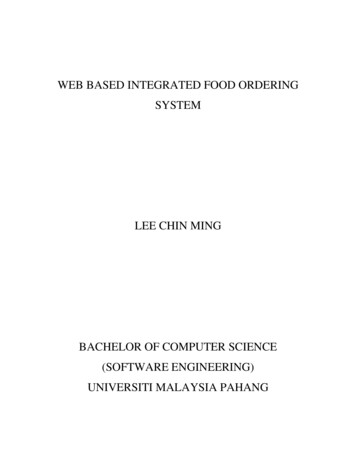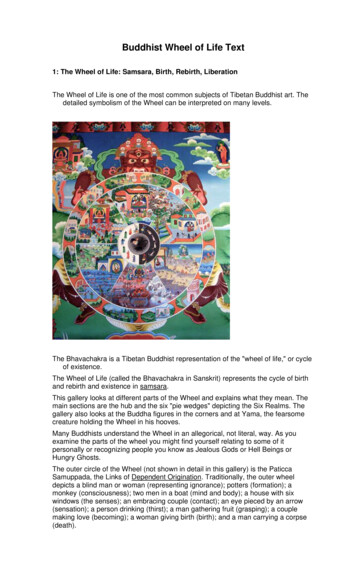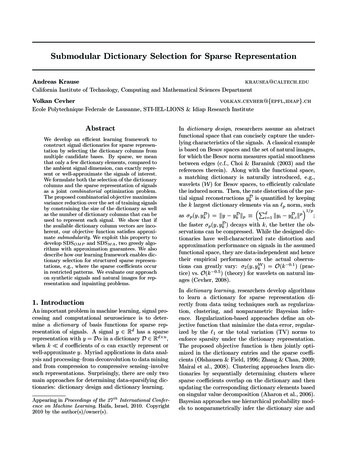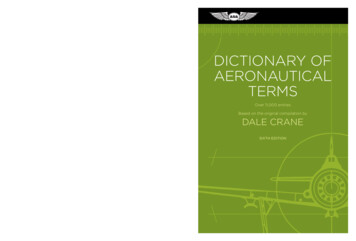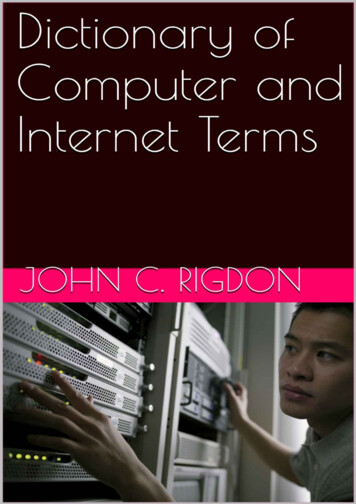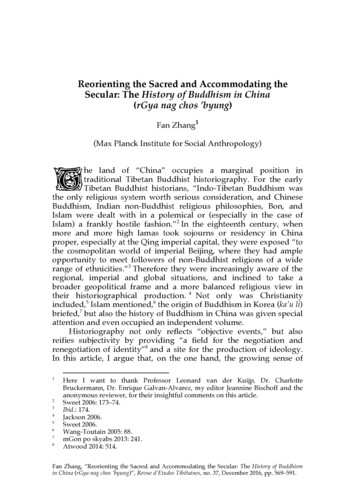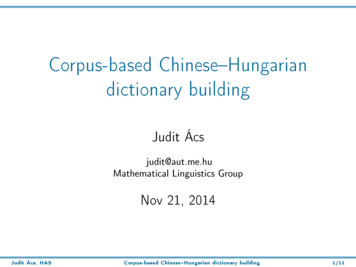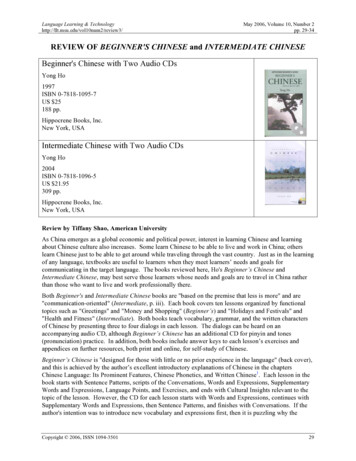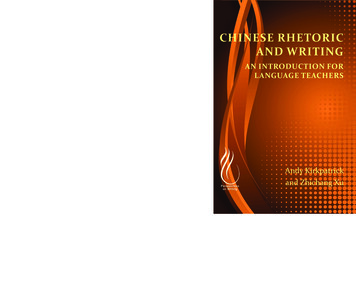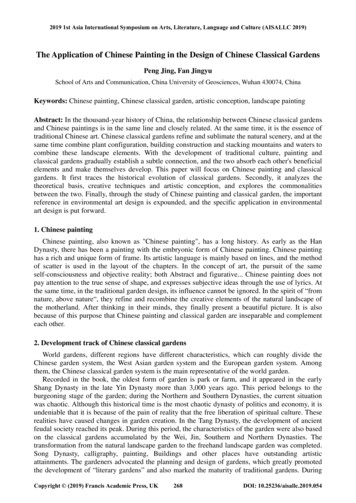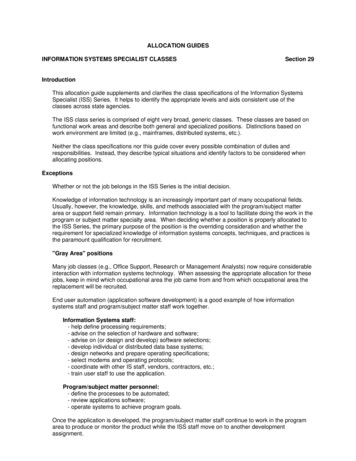
Transcription
A Dictionary of Chinese Buddhist TermsbyWilliam Edward SoothillandLewis HodousContents Preface to the Digital Editiono Why Digitize Soothill?o Status of the Digital Document and Treatment of its Contentso AcknowledgmentsProfessor Sooothill's PrefaceProfessor Hodous' PrefaceA DICTIONARY OF CHINESE-BUDDHIST TERMSDownload (HTML file and XML Source)Preface to the Digital EditionWhy Digitize Soothill?Like all other graduate students for the past generation or so who chose to embark on a professional careerin the study of East Asian Buddhism, I was, in my early days of study, strictly warned by my mentorsagainst relying on the Soothill and Hodous' Dictionary of Chinese Buddhist Terms as a primary researchtool. There were two main reasons for this. First, the dictionary is an extremely dated work, havingreached completion during the mid 1930's, several decades before a serious profession of Buddhology hadformed itself in the West. Western language information on Buddhism available to its compilers wasextremely limited, and even in East Asian there were few reliable and comprehensive lexicons available.Thus the understanding of the philosophical terminology coming out of such systems as Mādhyamika andYogācāra—which had only barely come to be understood in the West, tended to be simplistic, if notcompletely erroneous. It was a time in the history of the discipline when "Hīnayāna" was still consideredto be something of a distinct historical Buddhist tradition. Beyond this, even concepts contained in thedictionary that were adequately understood were often expressed in archaic terms.The second reason for pushing graduate students away from this work is related to the necessity of gettingthem involved as quickly as possible in dealing with resources from the original Asian traditions—in thiscase, the original texts and secondary resources from China, Korea, Japan, and Vietnam. Beyond this, the
constraints imposed by the printing technology of the 1930's have always made the dictionary somewhatdifficult to use, with many of the entries in the dictionary being embedded inside other entries. There isalso the difficulty brought about by the usage of vertical bars to indicate the repetition of Chinesecharacters. There is also somewhat of a dearth of useful indexing.Despite these shortcomings, the fact is that just about every serious scholar of East Asian Buddhism has acopy of the Soothill/Hodous dictionary in her/his personal library (perhaps stashed somewhere next to acopy of Mathew's). This is an indication of an important fact about the dictionary: there is a large amountof information contained within it that can't readily be found elsewhere. Most notably information onIndian and Central Asian place names, personal names, temple names and so forth, but also lots ofinformation on hybrid Sanskrit and transliterations that one will not find in any other dictionary, EastAsian or otherwise.I made the decision to digitize the dictionary upon finding out that it had fallen into the public domain,coupled with the realization that its content could do much to supplement that of my own long-termBuddhist lexicographical project, the Digital Dictionary of Buddhism [DDB(http://www.acmuller.net/ddb)]. Obtaining a grant from the Japan Society for the Promotion of Science[JSPS] I spent, along with a number of assistants, two years in the task of digitizing this material andadding it to the DDB.I became, in the process of this task, quite likely the only other person besides Soothill, Hodous, and theireditorial staff, to read the dictionary in its entirety, and as a result of this concentrated exposure to it, I wasled, as a fellow lexicographer, to come away with an immense respect for efforts of its compilers. Veryearly in the age of attempts at mixed Chinese-Roman typesetting, and several decades before the adventof copy machines, these two men, working on different continents, sent their handwritten manuscript backand forth by ship over the Atlantic ocean no less than four times.Serious scrutiny has led me to the conclusion that the work is, at least in terms of its translations fromChinese sources, fairly sound. Using modern computing technology in the process of adding this materialto the DDB, we were able to benefit from the presence of digitized versions of the Fanyi mingyi ji and theDing Fubao, which were checked (along with a wide range of other digitized resources) on the addition ofeach entry. This allowed us to add a good amount of information to the DDB from these sources thatSoothill and Hodous—no doubt in the interest of economy—left out. This also allowed us to see clearlythat both men held a very solid command of classical Chinese. Their renderings from these sources areaccurate, insightful, and nuanced. They also extensively and paintakingly consulted the other referenceworks that were available to them at the time, such as the lexicons by Eitel and Monier-Williams (seeSoothill's Preface for a discussion of sources). Making extensive use of Eitel, they were able to add asizeable amount of geographical location information for place names contained in the various travelrecords of Chinese monks who went to India and Central Asia.As noted above, the most obvious area of difficulty in terms of content was that concerned with Buddhistphilosophy. They were not aware at all of the complex nature of the relationship between the"Paramarthan" and Xuanzang Yogācāra (the "schools of Idealism"), but more telling (and historically,interesting) is the fact that they had not yet even sufficiently grasped the distinctions between Yogācāraand Vajrayāna, as these two traditions are conflated in a number of places. Also, not surprising for thetime period in which they worked and their backgrounds, much of their thinking was informed byChristian theology, and this is sometimes reflected in their renderings of Buddhist concepts. On the otherhand, since Soothill was one the early translators of the Lotus Sutra, it is not surprising to note that thereis a strong presence of Lotus and Tiantai related terminology in this work, most of it rendered withsufficient accuracy.
Status of the Digital Document and Treatment of its ContentsI started this project with only the intent of absorbing its data into the DDB in a supplementary fashion,and it was not until halfway through the process of digitization that it occurred to me that a separatedigital version of the dictionary made publicly available on the internet could be of sufficient value tomerit paying attention to the proper preservation of its original format. Thus, unfortunately, during theearly stages, almost all attention was paid to devising the most efficient strategies for preparation of thematerial for entry into the DDB. This preparation included the changing of Chinese transliterations intoPinyin, as well as correction of Sanskrit diacritics, and amendments in diacritical style according to themodern norms used the DDB. However, even this was not done with consistency, as sometimes thesechanges were made in the Dictionary source files, and sometimes only after they had been added to theDDB.The major format change one will see in this version is that of the places where Soothill/Hodous hadincluded numerous entries under a single entry heading. For ready absorption into the DDB usingcomputer programming, these were broken down into separate entries. As it turns out, it makes thedictionary much more readable, so I don't see that this will be a problem. Also, our replacement of thevertical bars with the actual Han characters they were used to indicate will make for much easier readingthan in the printed original.Most corrections to the material are usually only found in the equivalent DDB entry. Since we havealready gone through the correcting and editing process once while adding the material to the DDB, itdoes not seem worth it, for our purposes, to go back and try to return to Soothill material to its preciseoriginal format. But if someone would like to do that job, they are certainly welcome to do so. There islittle doubt that the addition of the material to the DDB in a more readily accessible, searchable format issomething that Profs. Soothill and Hodous would have themselves happily welcomed. Prof. Soothill'sattitude toward the usage of his work in future projects is well expressed as follows:Lack of time and funds has prevented our studying the Canon, especially historically, orengaging a staff of competent Chinese Buddhist scholars to study it for the purpose. Weare consequently all too well aware that the Dictionary is not as perfect or complete as itmight be.Nevertheless, it seems better to encourage the study of Chinese Buddhism as early aspossible by the provision of a working dictionary rather than delay the publication perhapsfor years, until our ideals are satisfied—a condition which might never be attained.We therefore issue this Compendium—for it is in reality more than a Dictionary—in thehope that many will be stimulated to devote time to a subject which presents so fascinatinga study in the development of religion.The basic digital document is structured in XML, using the recommendations for print dictionariesprovided by the Text Encoding Initiative [TEI]. This will allow for its transformation into various formatsfor implementation on the Web, and elsewhere. While the major portion of the work of development ofthe structure in the usage of TEI2 was done by Charles Muller, a significant housecleaning of thisstructure was done by Michael Beddow in the process of final production. The XSLT transformation wasdone based on the TEI style sheets developed by Sebastian Rahtz.Acknowledgments
The work of digitizing A Dictionary of Chinese Buddhist Terms was made possible by a research grantfrom the Japan Society for the Promotion of Science. The scanning and OCR work was done in itsentirety by Yasuko Suzuki. Ms. Suzuki also did almost all of the editing and correction of Chinesecharacters contained in the text. Proofreading of the English text, and especially the insertion of diacriticalmarks was done by Heather Blair, Juhn Ahn, Amanda Goodman, Gina Cogan, James Mark Shields, andThomas Dreitlein. Please note that due to certain processes of the project, not all of these correctionsappear in the present text, but are reflected in their entirety within the Digital Dictionary of Buddhism.Charles MullerTokyo, March 2003PROFESSOR SOOTHILL'S PREFACEAS compilers of the first Dictionary of Chinese Mahāyāna Terms, we are far from considering ourattempt as final. Our desire has been to provide a key for the student with which to unlock a closed door.If it serves to reveal the riches of the great Buddhist thesaurus in China, we will gladly leave to others thecorrection and perfecting of our instrument. It was Dr. E. J. Eitel, of The London Missionary Society, whoover sixty years ago, in 1870, provided the first means in English of studying Chinese Buddhist texts byhis Handbook for the Student of Chinese Buddhism. It has been of great service; but it did not deal withChinese Buddhist terminology in general. In form it was Sanskrit-Chinese-English, and the second editionunhappily omitted the Chinese-Sanskrit Index which was essential for the student reading the ChineseSutras. [Note:1. A reprint of the second edition, incorporating a Chinese Index, was published in Japan in 1904, but isvery scarce.]Lacking a dictionary of Chinese Buddhist terms, it was small wonder that the translation of Chinese textshas made little progress, important though these are to the understanding of Mahāyāna Buddhism,especially in its Far Eastern development. Two main difficulties present themselves: first of all, thespecial and peculiar use of numerous ordinary Chinese terms; and, secondly, the large number oftransliterated phrases.In regard to the first difficulty, those who have endeavoured to read Chinese texts apart from theapprehension of a Sanskrit background have generally made a fallacious interpretation, for the Buddhistcanon is basically translation, or analogous to translation. In consequence, a large number of termsexisting are employed approximately to connote imported ideas, as the various Chinese translatorsunderstood those ideas. Various translators invented different terms; and, even when the same term wasfinally adopted, its connotation varied, sometimes widely, from the Chinese term or phrase as normallyused by the Chinese. For instance, kleśa undoubtedly has a meaning in Sanskrit similar to that of 煩惱, i.e. affliction, distress, trouble.In Buddhism affliction (or, as it may be understood from Chinese, the afflicters, distressers, troublers)means the passions and illusions; and consequently fan-nao in Buddhist phraseology has acquired this
technical connotation of the passions and illusions. Many terms of a similar character will be noted in thebody of this work.Consequent partly on this use of ordinary terms, even a well-educated Chinese without a knowledge ofthe technical equivalents finds himself unable to understand their implications.A difficulty equally serious is the transliteration of Sanskrit, a difficulty rendered far greater by the variedversions of many translators. Take, for instance, the word "Buddha" and its transliteration as 佛; 佛陀; 浮陀, 浮圖, 浮頭, 勃陀, 勃馱, 部陀, 母陀, 沒馱, and so on. The pages of the Chinese canon are pepperedwith such transliterations as these from the Sanskrit, in regrettable variety. The position resembles that ofChinese terminology in Modern Science, which was often transliteration twenty or thirty years ago, whenI drew the attention of the Board of Education in Peking to the need of a regulated terminology forScience. Similarly, in pages devoid of capitals, quotation-marks, or punctuation, transliterated Sanskritinto-Chinese may well seem to the uninitiated, whether Chinese or foreign, to be ordinary phrases out ofwhich no meaning can be drawn.Convinced, therefore, that until an adequate dictionary was in existence, the study of Far Eastern Buddhisttexts could make little progress amongst foreign students in China, I began the formation of such a work.In 1921 I discovered in Bodley's Library, Oxford, an excellent version of the 翻譯名義 集 Fan I ming IChi, i.e. Translation of Terms and Meanings, composed by 法雲 Fa-y n, circa the tenth century A.D. Atthe head of each entry in the volume I examined, some one, I know not whom, had written the Sanskritequivalent in Sanskrit letters. These terms were at once added to my own card index. Unhappily the writerhad desisted from his charitable work at the end of the third volume, and the remaining seven volumes Ihad laboriously to decipher with the aid of Stanislas Julien's M thode pour d chiffrer et transcrire lesnoms sanscrits qui se rencontrent dans les livres chinois, 1861, and various dictionaries, notably that ofMonier Williams. Not then possessed of the first edition of Eitel's Handbook, I also perforce made anindex of the whole of his book. Later there came to my knowledge the admirable work of the Japanese 織田得能 Oda Tokunō in his 佛教大辭典; and also the Chinese version based upon it of 丁福 保 DingFubao, called the 佛學大辭典 in sixteen volumes; also the 佛學小辭典 in one volume. Apart from these,it would have been difficult for Dr. Hodous and myself to have collaborated in the production of this work.Other dictionaries and vocabularies have since appeared, not least the first three fascicules of the H b girin,the Japanese-Sanskrit-French Dictionary of Buddhism.When my work had made considerable progress, Dr. Y. Y. Tsu called upon me and in the course ofconversation mentioned that Dr. Hodous, of Hartford Theological Seminary, Connecticut, U.S.A., whohad spent many years in South China and studied its religions, was also engaged on a Buddhist Dictionary.After some delay and correspondence, an arrangement was made by which the work was divided betweenus, the final editing and publishing being allotted to me. Lack of time and funds has prevented ourstudying the Canon, especially historically, or engaging a staff of competent Chinese Buddhist scholars tostudy it for the purpose. We are consequently all too well aware that the Dictionary is not as perfect orcomplete as it might be.Nevertheless, it seems better to encourage the study of Chinese Buddhism as early as possible by theprovision of a working dictionary rather than delay the publication perhaps for years, until our ideals aresatisfied—a condition which might never be attained.We therefore issue this Compendium—for it is in reality more than a Dictionary—in the hope that manywill be stimulated to devote time to a subject which presents so fascinating a study in the development ofreligion.
My colleague and collaborator, Dr. Hodous, took an invaluable share in the draft of this work, and sinceits completion has carefully read over the whole of the typed pages. It may, therefore, be considered as thecommon work of both of us, for which we accept a common responsibility. It seemed scarcely possiblefor two men living outside China, separated by 2,000 miles of ocean, and with different mentalities andforms of expression, to work together to a successful conclusion. The risky experiment was hesitatinglyundertaken on both sides, but we have been altogether happy in our mutual relations.To Dr. F.W. Thomas, Boden Professor of Sanskrit, Oxford University, I am deeply indebted for his greatkindness in checking the Sanskrit terminology. He is in no way responsible for the translation from theChinese; but his comments have led to certain corrections, and his help in the revision of the properspelling of the Sanskrit words has been of very great importance. In the midst of a busy life, he has sparedtime, at much sacrifice, to consider the Sanskrit phrases throughout the entire work, except certainadditional words that have since come to my notice. As an outstanding authority, not only on the Sanskritlanguage, but on Tibetan Buddhism and the Tibetan language, his aid has been doubly welcome.Similarly, Dr. Hodous wishes specially to thank, his colleague at Trinity College, Hartford, Conn., Dr.LeRoy Carr Barret, for the generous assistance he rendered in revising the Sanskrit terms in his section ofour joint work, and for his well-considered and acceptable comments and suggestions.Dr. Lionel Giles, Keeper of the Department of Oriental Printed Books and MSS., British Museum,illustrious son of an illustrious parent, has also our special appreciation, for he magnanimously undertookto read the proofs. He brings his own ripe scholarship and experienced judgment to this long labour; andthe value and precision of the Dictionary will undoubtedly be enhanced through his accurate and friendlysupervision.Next, we would most gratefully acknowledge the gift of Mrs. Paul de Witt Twinem, of Trenton, NewJersey, UṢ.A. She has subscribed a sum of money which has made the publication of our work possible.To this must be added further aid in a very welcome subvention from the Prize Publication Fund of theRoyal Asiatic Society. Such a practical expression of encouragement by fellow-orientalists is a matter ofparticular gratification.Our thanks are due to Mr. Zu-liang Yih 葉樹梁, who with accuracy, zeal, and faithfulness has written thelarge number of Chinese characters needed. To the Hon. Mrs. Wood I am grateful for help in the exactingtask of transcribing. As to my daughter, Lady Hosie, I have no words to express my personal indebtednessto her. Without her loving and unflagging aid as amanuensis, I should have been unable to finish my partin this work, which-so the authors hope-will once again demonstrate the implicit and universal need of thehuman spirit for religion, and its aspirations towards the Light that "lighteth every man that cometh intothe world".W. E. SOOTHILL.Oxford, England, 1934.PROFESSOR HODOUS'S PREFACEAfter the Dictionary went to press, Professor Soothill died. The work on the Dictionary, however, wascompleted. For ten years we worked together, he at Oxford and I at Hartford, and the manuscript crossedthe Atlantic four times. During his semester in New York as Visiting Professor in Columbia University
and on my brief visit to Oxford, we had opportunity to consult together on some outstanding problems.The work of organizing the material and harmonizing the differences was done by Professor Soothill. Hewas well equipped to undertake the task of producing a Buddhist Dictionary, having a thoroughknowledge of the Chinese language. His Pocket Chinese Dictionary is still in use. He knew Chineseculture and religion. He possessed a keen sense for the significant and a rare ability to translate abstruseterms into terse English. But even more valuable was his profound insight into and deep sympathy withthe religious life and thought of another people.The text and the indexes were again finally revised during his last long illness by Lady Hosie under hissupervision. He was able also to appreciate the kind collaboration of Dr. Lionel Giles on the earlier proofsheets. But his death meant a vastly increased amount of work for Dr. Giles who, on the other side of theAtlantic from myself, has had to assume a responsibility quite unexpected by himself and by us. For twoto three years, with unfailing courtesy and patience, he has considered and corrected the very trying pagesof the proofs, while the Dictionary was being printed. He gave chivalrously of his long knowledge both ofBuddhism and of the Chinese literary characters. He adds yet another laurel to the cause of Chineselearning and research. And in the same way Professor F.W. Thomas bore the brunt of the Sanskrit proofreading. We have indeed been fortunate to have had our work checked in extenso by such exactingscholars.To Sir E. Denison Ross, who kindly looked over the proofs, and added certain welcome corrections, ourthanks are due. Also we would wish to acknowledge the help of Mr. L. M. Chefdeville, who, putting hisexperience of various Oriental languages at our disposal, made many helpful suggestions, especially asregards the Indexes. Nor do we forget the fidelity and careful work of the printers, Messrs. Stephen Austinand Sons, who collaborated with us in every way in our desire to produce a volume a little worthy of itsnotable subject.Our object is well expressed by my late colleague. The difficulties in the production of the book were notsmall. Buddhism has a long history. Its concepts were impregnated by different cultures, and expressed indifferent languages. For about a thousand yearsBuddhism dominated the thought of China, and her first-rate minds were occupied with Buddhistphilosophy. For a period it lagged; but today is in a different position from what it was a generation ago.Buddhism is no longer a decadent religion and in certain countries it is making considerable progress. It istherefore to be hoped that this Dictionary will help to interpret Chinese culture both through the ages andtoday.LEWIS HODOUS.Hartford, Connecticut, 1937.METHOD AND NOTES1. The rule adopted has been to arrange the terms, first, by strokes, then by radicals, i. e.: (a) By the number of strokes in the initial character of a term; then,(b) According to its radical.
Thus 佛 will be found under seven strokes and under the 亻 radical; 法 under eight strokes and the 氵radical; 愛 under thirteen strokes and the 心 radical. A page index is provided showing where changes inthe number of strokes occur.2. A list of difficult characters is provided.3. An index of the Sanskrit terms is given with references to the Chinese text.4. A limited number of abbreviations have been used, which are self-evident, e.g. tr. for translation,translator, etc.; translit. for transliteration, transliterate, etc.; abbrev. for abbreviation; intp. for interpretedor interpretation; u.f. for used for. "Eitel" refers to Dr. Eitel's Handbook of Chinese Buddhism; "M.W." toMonier-Williams' Sanskrit-English Dictionary; "Keith" to Professor A. Berriedale Keith's BuddhistPhilosophy; "Getty" to Miss Alice Getty's The Gods of Northern Buddhism; B.D. to the 佛學大辭典; B.N.to Bunyiu Nanjio's Catalogue.5. Where characters are followed by others in brackets, they are used alone or in combination; e. g. in 十善 (正法) the term 十善 may be used alone or in full 十善正法.6. In the text a few variations occur in the romanization of Sanskrit and other non-Chinese words. Thesehave been corrected in the Sanskrit index, which should be taken as giving the correct forms.In this Dictionary it was not possible to follow the principle of inserting hyphens between the members ofSanskrit compound words.A DICTIONARY OF CHINESE-BUDDHIST TERMS[1]1. ONE STROKE一 eka. One, unity, monad, once, the same; immediately on (seeing, hearing, etc.).一一 One by one, each, every one, severally.一丈六像 Sixteen 'feet' form, or image, said to be the height of the Buddha's body, or 'transformation'body; v. 丈六金身.一三昧 ekāgra, aikāgrya. Undeflected concentration, meditation on one object; v 一行三昧.一中 A hall of spread tables; idem 一普.一中一切中 One being recognized as 'mean' then all is of the 'mean'; the three aspects of reality,noumenon, phenomenon, and madhya, are identical in essence; v. 止觀 5.
一乘 ekayāna, One yāna, the One yāna, the vehicle of one-ness.一佛乘 The one Buddha-yāna. The One Vehicle, i.e. Mahāyāna, which contains the final or completelaw of the Buddha and not merely a part, or preliminary stage, as in Hīnayāna. Mahāyānists claim it as theperfect and only way to the shore of parinirvāṇa. It is especially the doctrine of the 法華經 Lotus Sūtra; v.大乘.一乘之珠 The pearl of the One yāna, i.e. The Lotus Scripture.一乘圓宗 The Tiantai, or Lotus School of the perfect teaching, or the one vehicle; v. 天台宗.一乘家 The one-vehicle family or sect, especially the Tiantai or Lotus School.一乘法 (一乘法門) The one vehicle method as revealed in the Lotus Sūtra.一乘究竟教 The One Vehicle in its final teaching, especially as found in the Lotus Sūtra.一乘經 一乘妙典 (or 一乘妙文) Another name for the Lotus Sūtra, so called because it declares theone way of salvation, the perfect Mahāyāna.一乘菩提 The one-vehicle enlightenment.一乘顯性教 One of the five divisions made by 圭峯 Guifeng of the Huayan 華嚴 or AvataṃsakaSchool; v. 五教.一九 A Shingon term for Amitābha.一九之生 Future life in the Amitābha Pure Land.一人作虛萬人傳實 One man's untruth is propagated by a myriad men as truth; famae mendacia.一代 A human lifetime; especially the lifetime of Śākyamuni on earth.一代三段 The three sections, divisions, or periods of Buddha's teaching in his life- time, known as 序分, i.e. the 華嚴, 阿含, 方等, and 般若 sūtras; 正宗分, i.e. 無量義, 法華, and 普賢觀 sūtras; and 流通分,i.e. the 湼槃經; they are known as introductory, main discourse, and final application. There are otherdefinitions.一代五時佛法 The five period of Buddha's teachings, as stated by Zhiyi 智顗 of the Tiantai School.The five are 華嚴, 阿含, 方等, 般若, 法華湼槃, the last two being the final period.
一代教 The whole of the Buddha's teaching from his enlightenment to his nirvāṇa, including Hīnayānaand Mahāyāna teaching.一位一切位 idem 一門不門.一佛世界 A Buddha-cosmos; a world undergoing transformation by a Buddha.一佛乘 The Mahāyāna, or one-Buddha vehicle, especially the teaching of the Lotus Sūtra.一佛土 (一佛國土); idem 一佛世界 A Buddha-domain; or a one-Buddha region; also the Pure Land.一佛多佛 One Buddha or many Buddhas, i.e. some Hīnayāna Schools say only one Buddha exists inthe same aeon; Mahāyāna says many Buddhas appear in the same aeon in many worlds.一佛淨土 A Buddha's Pure Land, especially that of Amitābha.一來 (一來向) sakṛdāgāmin. Only one more return to mortality, v. 斯 and 四向.一來果 v. 四果.一個半個 A particle, the very least.一光三尊 Three honoured ones in one light or halo—Amitābha, Avalokiteśvara, andMahāsthāmaprāpta; or Śākyamuni, Bhaiṣajya the 藥王 and 藥上 his younger brother.[2]一兎毛塵 An atom of dust on a hare's down (śaśorṇa). A measure, the 22,588,608,000th part of ayojana.一囘忌 The first anniversary of a death; any such anniversary; also 一周忌.一刀三禮 In carving an image of Buddha, at each cut thrice to pay homage to the triratna. 一筆三禮and 一字三禮 indicate a similar rule for the painter and the writer.一分家 A school founded by 安慧 Anhui, teaching 心識之一分說 that cognition is subjective.一分菩薩 A one-tenth bodhisattva, or disciple; one who keeps one-tenth of the commandments.
一切 sarva. All, the whole; 普, 遍, 具.一切一心識 That all things are mind, or mental.一切世尊最尊特身 The most honoured of all the world-honoured; a title of Vairocana; v. 毘.一切人中尊 The most honoured among men, especially Vairocana; v. 毘.一切佛心印 trikona. The sign on a Buddha's breast, especially that on Vairocana's; the sign of theBuddha-mind; it is a triangle of flame pointing downwards to indicate power overall temptations; it is also一切徧智印 the sign of omniscience.一切佛會 The assembly of all the Buddhas, a term for the two maṇḍalas, or circles; v. 胎藏界 and, 金剛界, i.e. the Garbhadhātu and the Vajradhātu.一切卽一 v. 一卽一切.一切如來 sarvatathāgata, all Tathāgatas, all the Buddhas.一切如來定 The highest of the 108 degrees of samādhi practised by bodhisattvas, also called 大空三昧 śūnyasamādhi, i.e. of the great void, or immateriality, and 金剛三昧 vajrasamādhi, Diamond samādhi.A samādhi on the idea that all things are of the (same) Buddha-nature.一切如來寶 The talismanic pearl of all Buddhas, especially one in the Garbhadhātu maṇḍala whoholds a lotus in his left hand and the talismanic pearl in his right.一切如來必定印 The sign of the assurance of attaining Buddhahood.一切如來智印 A sign of the wisdom of all buddhas, a triangle on a lotus in the Garbhadhātu group.一切如來眼色如明照三摩地 A Vairocana-samādhi, in which the light of the Tathāgata-eyestreams forth radiance. Vairocana by reason of this samādhi is accredited with delivering the 'true word'which sums up all the principles and practices of the masters.一切如來諸法本性淸淨蓮華三昧 A lotus-samādhi of Vairocana from which Amitābha wasborn. It is a Tathāgata meditation, that the fundamental nature of all existence is pure like the lotus.一切如來金剛誓誡 The original oath of every Tathāgata, when as with the roar of a lion hedeclares that all creatures shall
against relying on the Soothill and Hodous' Dictionary of Chinese Buddhist Terms as a primary research tool. There were two main reasons for this. First, the dictionary is an extremely dated work, having reached completion during the mid 1930's, several decades before a serious profession of Buddhology had formed itself in the West.
